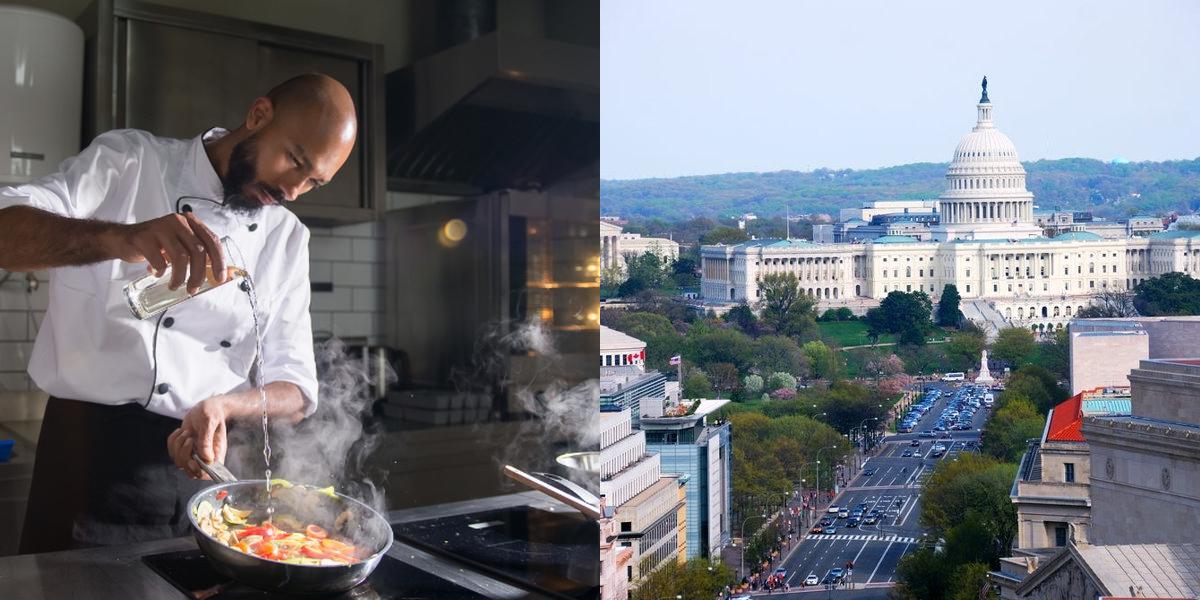How to Become a Chef in District of Columbia

What is Culinary Arts?
Culinary Arts is the art and science of preparing and cooking food. Culinary professionals, also known as chefs, are responsible for creating delicious and visually appealing dishes. They use their creativity and knowledge of various ingredients and cooking techniques to bring flavors to life. Additionally, chefs often oversee kitchen operations, manage staff, and ensure food safety and quality.
Step 4: Polish Your Culinary Skills
Continuously improving your culinary skills is essential to stay relevant and competitive in the industry. Take advanced culinary courses, attend workshops or seminars, and stay updated with the latest culinary trends and techniques. Experiment with new ingredients, cuisines, and cooking methods to expand your repertoire and showcase your versatility as a chef. The more diverse and refined your culinary skills are, the more attractive you will be to potential employers.
Step 5: Apply for Culinary Positions
Once you have built a strong culinary portfolio, gained work experience, networked with industry professionals, and polished your culinary skills, it's time to start applying for culinary positions. Look for job openings in restaurants, hotels, resorts, catering companies, culinary schools, or private households. Tailor your resume and cover letter to highlight your relevant skills and experiences, and follow up on your applications to demonstrate your enthusiasm and dedication.
Step 6: Ace the Interview
If you are invited for an interview, make sure to prepare thoroughly to increase your chances of success. Research the company or establishment beforehand, familiarize yourself with their menu or specialty, and be prepared to answer questions about your culinary background, skills, and goals. Dress professionally, be punctual, and demonstrate your passion and enthusiasm for the culinary arts. A confident and well-prepared interview can leave a lasting impression on potential employers and increase your chances of getting hired.
Career Paths and Opportunities after Becoming a Culinary Arts
After becoming a certified culinary arts professional, there are various career paths and opportunities available to you in the culinary industry. Here are some common career paths you can consider:
1. Executive Chef
As an executive chef, you will be responsible for overseeing the entire kitchen operations in a restaurant or hotel. You will create menus, manage kitchen staff, ensure food quality and safety standards, and oversee the preparation and presentation of dishes. This is a leadership role that requires excellent culinary skills, managerial abilities, and a strong understanding of food and flavor profiles.
2. Sous Chef
A sous chef works closely with the executive chef and assists in managing the kitchen operations. You will be responsible for supervising kitchen staff, coordinating food preparation, and ensuring that dishes are cooked and presented according to the executive chef's standards. This role requires strong organizational skills, the ability to work under pressure, and a good understanding of culinary techniques and flavor combinations.
3. Pastry Chef
If you have a passion for desserts and baked goods, becoming a pastry chef might be the right career path for you. As a pastry chef, you will be responsible for creating and preparing a variety of pastries, cakes, and desserts. You will need to have a strong understanding of baking techniques, flavor pairings, and presentation skills. Pastry chefs often work in bakeries, patisseries, hotels, or restaurants with a dedicated pastry department.
4. Personal Chef
As a personal chef, you will work directly with individual clients or families to create customized menus and prepare meals in their homes. This career path offers flexibility and allows you to showcase your culinary skills while building personal relationships with clients. Personal chefs often cater to clients with specific dietary needs or preferences, and they may be responsible for grocery shopping, menu planning, and meal preparation.
5. Food Stylist
If you have an eye for aesthetics and a passion for photography, becoming a food stylist might be a suitable career path. Food stylists work closely with photographers, chefs, and advertising agencies to create visually appealing food images for cookbooks, magazines, advertisements, and social media. This role requires creativity, attention to detail, and a solid understanding of food presentation and styling techniques.
6. Culinary Educator
If you enjoy sharing your knowledge and skills with others, becoming a culinary educator might be a fulfilling career path. Culinary educators work in culinary schools, vocational institutions, or community colleges, teaching aspiring chefs the art and science of cooking. This role requires excellent communication skills, a deep understanding of culinary techniques, and the ability to create engaging and informative lesson plans.
7. Food Writer or Critic
If you have a passion for writing and a keen palate, becoming a food writer or critic can be an exciting career path. Food writers and critics review restaurants, write articles or blog posts about food and culinary trends, and may contribute to magazines, newspapers, or online publications. This career path allows you to combine your love for food and writing and share your culinary experiences and insights with a wider audience.
These are just a few examples of the many career paths and opportunities available to certified culinary arts professionals. The culinary industry is diverse and ever-evolving, offering endless possibilities for growth and creativity.
How Much does a Chef make?
The salary of a chef can vary depending on several factors, including experience, location, and the type of establishment they work in. On average, chefs in the United States earn a median annual salary of around $51,530, according to the Bureau of Labor Statistics. However, starting salaries for entry-level chefs can be lower, typically ranging from $25,000 to $35,000 per year.
It's important to note that these figures are just averages, and individual salaries can vary significantly. Experienced and well-known chefs who work in high-end restaurants or run their own establishments can earn six-figure salaries or even more.
How Much does a Chef make?
The salary of a chef can vary depending on several factors, including experience, location, and the type of establishment they work in. On average, chefs in the United States earn a median annual salary of around $51,530, according to the Bureau of Labor Statistics. However, starting salaries for entry-level chefs can be lower, typically ranging from $25,000 to $35,000 per year.
It's important to note that these figures are just averages, and individual salaries can vary significantly. Experienced and well-known chefs who work in high-end restaurants or run their own establishments can earn six-figure salaries or even more.
Final Thoughts
Obtaining a culinary arts certification is an excellent way to turn your passion for cooking into a rewarding career. By enrolling in a culinary arts program, gaining practical experience, and passing the certification exam, you can prove your skills and open up doors to a variety of job opportunities in the culinary industry.
Remember, becoming a chef requires dedication, passion, and continuous learning. With the right education and training, combined with your culinary skills and creativity, you can embark on an exciting culinary arts career in the beautiful state of District of Columbia.
If you're someone who values exploring multiple career options and wants to find the best match for your interests, feel free to check out these additional articles:

Jessa Guzon is a member of the School Growth and Customer Success Team in Dreambound. She finds joy in assisting both schools and students in reaching their goals by answering their queries and connecting them with the right people. Outside her professional role, Jessa is a happy-go-lucky person with a thirst for adventure.




